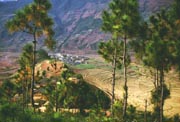Course
Home
Class schedule
E-mail the class
READING
Here's a state of things
Local Ecologies
Grand Histories
Modern Predicaments
What next?
WRITING
Local Ecologies
Grand Histories
Modern Predicaments
What Next?
|
Readings for Unit 2: The Ecology of Local Communities
For this unit, we first look at two conceptual frameworks, one theoretical and one geographic:
- We will begin with two important concepts that will inform our understanding of China's environmental history and its environmental present: sustainability and resilience. To start understanding these concepts, you should read two short theoretical pieces: Simon Levin et al.'s "Resilience in Natural and Socioeconomic Systems," p. 222-234 in the Policy Forum on Resilience and Sustainability (you're welcome to read more, of course), and Robert Solow's Sustainability: an Economist's Perspective. If you get really interested in the topic, and especially if you are a graduate student, you should read two chapters from Lance Gunderson and C.S. Holling's Panarchy, which give you a deeper and more complex understanding that you may wish to use in your writing later on. We can spend a little time discussing these concepts in class on Tuesday, April 5, if you have questions.
- Joseph Whitney's chapter on East Asian Agriculture, from G. A. Klee's World Systems of Traditional Resource Management, where Whitney divides China's traditional productive landscapes into three ecological zones: peasant "gardening," which I call intensive agriculture, upland minority mixed shifting and fixed cultivation, and dry-zone pastoralism, and examine case studies of each with a view to the their long-term sustainability and resilience. This geographical framework will also help you prepare for your basic quiz, which you will be taking on Thursday, April 21.
Tuesday, April 5: Chinese Farmers
Today we will address the topic of ecological sustainability and resilience as it is shown in the interaction between local village ecologies of Han Chinese farmers and the regional agro-urban economies of which they were a part. To prepare for this, you should read the detailed descriptions of the agricultural ecology of two villages, both by anthropologists writing about the situation in the early 20th century:
- In the rice-growing south, Fei Xiaotong (Fei Hsiao-t'ung), Peasant Life in China, describes land and agriculture in the village of Kaixiangong (Kai-hsien Kung) in his native Wujiang (Wukiang) county in Jiangsu, from his fieldwork in the early 1930s.
- In the dry-grain growing north, Yang Maochun (Martin M.C. Yang), in A Chinese Village describes land and agriculture in his own native village, Taitou, near the city of Qingdao (Tsing-tao, yes, that's where they make beer) on the coast of Shandong, based on his childhood memories from the 1920s.
As an optional but reinforcing reading to accompany my lecture, you might want to read my chapter from Ecohistory on The Ecology of the Chinese Peasant Household. But it's long and involved, so don't feel obligated. There is also a slide show of the same material.
In class, we will apply ecosystem thinking to analysis of Han village agricultural systems. Think about the ways in which the local ecology in the villages described by Fei and Yang was or was not resilient at the time these descriptions were written. Be sure to keep in mind the ways in which the local communities were also parts of larger, regional systems.
Thursday, April 7: Upland minority mixed farmers
We will be approaching this next variety of local ecology through two resources, Janet Sturgeon's work among the Akha in China--in this case on the Yunnan-Burma border, and in Thailand, as described in your required text Border Landscapes, and my own work among the Nuosu of the Liangshan region of southwestern Sichuan. We will concentrate both on the ecology and especially on the ethno-ecology, or the ways that local people see and understand their own environment.
If you like, you might also want to read my my draft chapter on the ecology of upland peoples.
For the Akha case, read Border Landscapes; the review of the book will be due on Monday, April 11. For the Nuosu case, which I will present in detail in a PowerPoint lecture today, I have also prepared a short summary of Nuosu Ethnoecology and Ecohistory which will cover much of the same material, and my lecture slides from the same day give you a triple whammy.
Tuesday, April 12: Pastoralists of Mongolia, Tibet, and Xinjiang
Chinese macro-history has been, in some sense, a story of the ecological and cultural frontier between the agricultural and pastoral zones. For today, we both examine the nature of the boundary itself, along with its historical influence, and cross the boundary and look at ecology from a pastoralist perspective. You may want a summary of the ecological perspective, to be found in my chapter draft on the topic, as well as the some of the same material in slide format, and finally, lecture notes.
However, don't just read my stuff over and over. For the boundary, read The Steppes of Mongolia from Owen Lattimore's classic Inner Asian Frontiers of China
For the pastoralist perspective in Mongolia explicitly contrasted to the settled, agricultural perspective, read Dee Mack Williams's The Land in Cultural Context from his Beyond Great Walls, which is based on fieldwork in the 1990s but describes attitudes which he presumes have been there for a long time; for the pastroalist perspective in Xinjiang, read Ingvar Svanberg's The Nomadism of the Orta 3Ÿz Kazaks in Xinjiang, 1911-1949, with particular attention to pages 121-140. For Tibet, read the description of ecology on the Tibetan Plateau from Melvyn Goldstein and Cynthia Beall's Nomads of Western Tibet, based on fieldwork in the 1980s, but also describing the traditional system before 1959. In class, we will look for common characteristics and the contrast to Chinese intensive agriculture.
|



